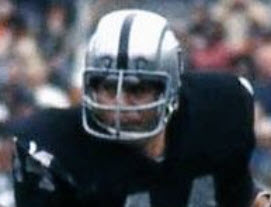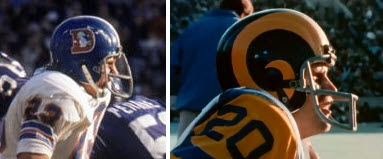LOOKING AHEAD
By John Turney
In 1969 the Pro Football Hall of Fame had the voting committee choose a 50th Anniversary NFL Team. For the 75th Anniversary, in 1994, the NFL had a select
committee pick a team for the Diamond Anniversary:
Ina few years there with be a 100th Anniversary Team and we wonder what players from the past 25 seasons may crack the list.
The 50th Anniversary Team had 15 players and 30 runners-up a total of 45 players. The 75th Anniversary Team had 48 players. We don't know if there will be a team with, say, 45 or 48 players or if they will expand the number. We suppose they will, and hope they will. For the purposes of this
excercise, we will assume it will be more.
Let's start with the special teams. In 1970 the kicker was Lou Groza and no punter or returner was chosen though there were players who could have filled those roles.
In 1994 Ray Guy and Jan Stenerud were the punter and kicker, respectively and Billy "White Shoes" Johnson was the return specialist.
We think
Devin Hester will likely supplant Johnson as the punt returner. His 14 punt return touchdowns and 5 kick returns for scores are simply too great to ignore. Josh Cribbs has 8 kickoff returns for touchdowns, which is the record, but Hester's 19 total are far and away the most. Cribbs was also a good core special teams player, covering kicks and
punts but Hester was the most productive returner.
Cribbs could challenge
Gale Sayers as the kick returner, though, but Sayers did a lot
in a shorter time. The "eye test" would favor Sayers in our view.
Dante Hall was a great returner with 6 punts and 6 kicks returned for
touchdowns but Sayer's 6 returns in 91 chances is a 6.6%, the highest of all time among
qualifiers, so we think he will retain the KR spot, he'd get our vote.
It may be that the NFL will add a special teams player and our best guess if they do, would be that
Steve Tasker would get that nod. Would
agree but would hope that some of the others core
STers would at least be in the discussion.
Hank Bauer,
Bill Bates,
Reyna Thomspson,
Kassim Osgood,
Brendon Ayanbadejo,
Ivory Sully, and many, many others were also stellar in coverage, blocking and blocking kicks. However, Tasker did it at a high level for a long time and was an All-Pro and Pro Bowler more often than the others.
Jan Stenrud and
Morten Anderson are the two Hall of Fame kickers, along with
Lou Groza who was a starting tackle for the first two-thirds of his career. In terms of stats, Groza was far ahead of his peers in terms of his averages. Pro Football Research Association member Rupert Patrick has an
upcoming book that with show his metric of "Points above League Average". He calculates how many points a particular kicker
scores in relation to his peers.
Groza, Anderson, and Stenerud all rank very high, but none are at the top. We won't give away who his top kicker is, we will let him reveal that in his book. However, one current kicker is doing very well versus his peers and that is
Justin Tucker.
Our view is that if Tucker keeps it up he could challenge the "Big Three". Apart from that, it will likely be Anderson (a two-time All-Decade performer) or Stenerud.
Ray Guy is the only punter in the Hall of Fame. He will likely get the nod again. However, keep and eye out for
Johnny Hekker. Playing for a mediocre-to-poor team in his five years Hekker owns almost every record in the book, both in terms of gross stats and in terms of "metrics".
Guy was All-Pro six times, Hekker three times in five seasons. Guy's Inside-the-20 to touchback ratio was 1.5 to one. Hekker's is currently 8.3 to 1. Almost double the next best (Dustin Colquitt's 4.6 to one—though when Sam Martin qualifies he will be around the same). But 8.3 to 1? It's unheard of.
Guy only had 3 punts blocked, which is excellent (0.3%). Hekker has had one blocked and his block percentage is 0.2%. For comparison,
Jerrel Wilson, the Chief's great has 12 blocked for 1.1%.
Hekker had, so far, had 38.2% of his punts end up inside the twenty yard-line. Only Dustin Colquitt has a higher percentage (40.5%). Guy's percentage is 24.6% in that metric.
Hekker's net punting average is 43.3 as of the end of the 2016 season. The next closest is
Thomas Morstead of the Saints with a 41.2 net average, nearly two yards fewer than Hekker and in this kind of statistic that is a lot since most of the best net yardage punters are all bunched around 40.0. Guy's career net punting average was 35.2, which is good, but not great, either, even for his time.
Certainly, Hekker will have to keep up this kind of performance for the next few years to catch they eye of whoever is on the voting committee but if he does, he cannot be ignored, even if the Rams don't improve because as of now, he's the best punter ever.
It will be interesting to follow these players and see if the up-and-comers like Hekker and Tucker can sustain their greatness.
Stay tuned for the next parts of this new series.













































































